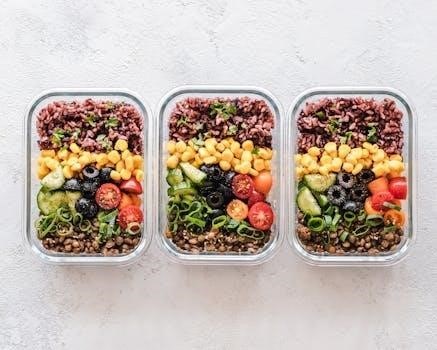What is Intermittent Fasting?
Intermittent fasting (IF) is an eating pattern that cycles between periods of eating and voluntary fasting on a regular schedule. It’s not a diet that specifies which foods you should eat‚ but rather when you should eat them.

Popular Intermittent Fasting Methods
Several intermittent fasting methods exist‚ each with varying fasting and eating windows. Common approaches include the 16/8 method‚ involving 16 hours of fasting and an 8-hour eating window‚ the 5⁚2 diet where you eat normally five days and restrict calories on two‚ and alternate-day fasting.
16/8 Method
The 16/8 method‚ a popular intermittent fasting approach‚ involves fasting for 16 hours and restricting your daily eating window to 8 hours. Many find it sustainable as it often means skipping breakfast and eating lunch and dinner within the eight-hour window. This allows your body to burn fat for energy during the fasting period.
This method is believed to be the easiest and most sustainable. Typically‚ you eat two or three meals within that 8-hour eating period. A satisfying‚ balanced‚ easy-to-follow plan will make it easier to stick to the new fasting schedule.
It’s crucial to consume nutrient-dense foods during your eating window. People often skip breakfast and have their first meal around noon‚ finishing with dinner by 8 p.m.
5⁚2 Diet
The 5⁚2 diet is another type of intermittent fasting where you eat normally for five days a week and significantly reduce your calorie intake on the other two days. On these fasting days‚ calorie intake is typically restricted to 500 calories for women and 600 calories for men. This approach allows for flexibility‚ as you don’t have to fast every day.
On the two fasting days‚ it’s important to choose nutrient-dense‚ low-calorie foods.
The 5⁚2 fast involves eating normally for five days of the week but fasting with a lowered calorie intake—between 500 and 800 calories—the other two days.
Some people use meal replacements on fasting days to help manage calorie intake. It can be effective for weight loss.
Alternate-Day Fasting
Alternate-day fasting (ADF) is a more intense form of intermittent fasting where you alternate between days of normal eating and days of fasting. On fasting days‚ you typically consume around 500 calories‚ while on eating days‚ you eat freely.
This method can be challenging for some people due to the frequent fasting. It requires careful planning to ensure you’re getting enough nutrients on both fasting and non-fasting days. It’s also essential to stay hydrated and listen to your body’s signals.
ADF is not suitable for everyone‚ especially those with certain health conditions. Consulting a healthcare professional before starting ADF is highly recommended. Some people find it easier to adapt compared to other methods.
Benefits of Intermittent Fasting
Intermittent fasting has gained popularity due to its potential health benefits. Some studies suggest that it can aid in weight loss by reducing overall calorie intake and boosting metabolism. During fasting periods‚ your body may burn stored fat for energy.
IF may also improve insulin sensitivity‚ which is crucial for blood sugar control. Some research indicates that intermittent fasting can promote cellular repair processes and protect against chronic diseases. Additionally‚ it might have positive effects on brain health and cognitive function.
It is important to note that the benefits of intermittent fasting can vary from person to person. It’s essential to consult with a healthcare professional before starting any new dietary regimen‚ especially if you have underlying health conditions.

Sample 16/8 Intermittent Fasting Meal Plan (PDF)
A 16/8 intermittent fasting meal plan involves fasting for 16 hours and eating within an 8-hour window. Many find this approach sustainable and effective for weight management and overall health.
To make it even easier‚ consider downloading a sample 16/8 intermittent fasting meal plan in PDF format. This type of resource can provide a structured guide to help you stay on track with your fasting and eating schedule. A well-designed meal plan often includes a balance of proteins‚ healthy fats‚ and complex carbohydrates.
Having a PDF template on hand‚ either printed or stored on your phone‚ can provide quick access to meal ideas and portion guidelines. This can be especially helpful when you are just starting out with intermittent fasting. Remember to adjust the meal plan to fit your individual needs and preferences.
Nutrient-Dense Food Suggestions for IF
When practicing intermittent fasting‚ particularly during your eating windows‚ focusing on nutrient-dense foods is crucial for maximizing health benefits and maintaining energy levels. These foods provide essential vitamins‚ minerals‚ and macronutrients while keeping you feeling full and satisfied.
Prioritize lean proteins such as chicken‚ fish‚ and legumes to support muscle mass and satiety. Incorporate healthy fats from sources like avocados‚ nuts‚ and olive oil for hormone balance and brain function. Choose complex carbohydrates like whole grains‚ vegetables‚ and fruits for sustained energy and fiber intake.
Leafy greens‚ berries‚ and colorful vegetables are packed with antioxidants and vitamins‚ supporting overall well-being. Remember to stay hydrated by drinking plenty of water‚ especially during fasting periods. By focusing on nutrient-dense foods‚ you can optimize the benefits of intermittent fasting and support your health goals.
Meal Prep Tips for Intermittent Fasting
Effective meal preparation is key to successfully implementing intermittent fasting‚ ensuring you have nutritious and satisfying meals ready during your eating windows. Start by planning your meals for the week‚ taking into account your dietary needs and preferences.
Batch cooking is a great strategy; prepare large portions of proteins‚ grains‚ and vegetables that can be easily combined into meals. Portion out your meals into containers for grab-and-go convenience‚ especially helpful on busy days. Chop vegetables and fruits in advance to save time during meal assembly.
Consider overnight oats or chia seed pudding for quick and healthy breakfast options. Keep healthy snacks like nuts‚ seeds‚ or hard-boiled eggs readily available to prevent overeating during meals. Label your containers with the date and contents to keep track of what you’ve prepared. By incorporating these meal prep tips‚ you can stay organized‚ avoid unhealthy choices‚ and maintain consistency with your intermittent fasting schedule.

Tracking Progress and Consistency
Maintaining consistency and tracking progress are crucial for success with intermittent fasting. Start by setting realistic and measurable goals‚ such as weight loss‚ improved energy levels‚ or better sleep. Keep a food journal to monitor your calorie intake‚ macronutrient ratios‚ and how you feel after each meal.
Use a fitness tracker or app to monitor your fasting windows and eating periods‚ ensuring you adhere to your chosen IF method. Weigh yourself regularly‚ but avoid obsessing over the numbers; focus on overall trends. Take body measurements and progress photos periodically to visually track changes. Pay attention to non-scale victories‚ such as increased energy‚ better mood‚ and improved digestion.
Plan your meals in advance and stick to a consistent eating schedule to regulate your hunger cues. Stay hydrated by drinking plenty of water throughout the day. Adjust your IF schedule and meal plan as needed based on your progress and how your body responds. Seek support from friends‚ family‚ or an online community to stay motivated and accountable.
Intermittent Fasting and Keto Meal Plan
Combining intermittent fasting (IF) with a ketogenic (keto) diet can amplify the benefits of both approaches. A keto diet involves consuming high fats‚ moderate protein‚ and very low carbohydrates‚ inducing a metabolic state called ketosis‚ where the body burns fat for fuel instead of glucose. When combined with IF‚ the body becomes even more efficient at burning fat due to prolonged periods without carbohydrate intake.
A typical keto IF meal plan might involve a 16/8 fasting schedule‚ where you fast for 16 hours and eat during an 8-hour window. During the eating window‚ meals should be keto-friendly‚ focusing on foods like avocados‚ fatty fish‚ nuts‚ and non-starchy vegetables. Planning your meals in advance is essential to ensure you meet your macronutrient goals and stay within your calorie limits. This combination requires careful planning and attention to nutrient intake to ensure adequate nutrition. Consult with a healthcare professional or registered dietitian before starting this approach.

Consulting a Healthcare Professional
Before embarking on any new dietary regimen‚ especially one as potentially impactful as intermittent fasting (IF)‚ it’s crucial to consult with a qualified healthcare professional. This consultation is particularly important if you have pre-existing health conditions‚ such as diabetes‚ heart disease‚ or a history of eating disorders. A doctor or registered dietitian can assess your individual health needs‚ evaluate potential risks‚ and determine if IF is a safe and appropriate option for you.
They can also provide personalized guidance on how to implement IF safely and effectively‚ taking into account your medical history‚ current medications‚ and lifestyle factors. Furthermore‚ a healthcare professional can monitor your progress‚ adjust your plan as needed‚ and help you address any challenges or concerns that may arise along the way. Seeking professional advice ensures that you approach IF in a way that supports your overall health and well-being.

No Responses